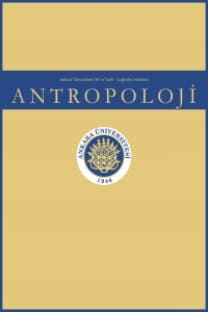Antropoloji, Arkeoloji ve Sanat Tarihi Profesyonellerinde İskelet Sistemi Sorunları
Anadolu birçok medeniyet tarafından iskân edilmiştir ve birçok kazı bu medeniyetlerin izlerini ortaya çıkarmaktadır. Kazı aktivitesi ağır bir fiziksel iş olup bu ağır işin bir kısmı antropolog, arkeolog ve sanat tarihçileri tarafından gerçekleştirilmektedir. Bu ağır çalışma da, uzun vadede iskelet sistemini etkilemektedir. Bu ağır çalışmanın etkileri olup olmadığını görmek için bir anket düzenlenmiştir. Bu çalışmanın amacı en çok rastlanılan iskelet sistemi sorunlarını ve bunların sebeplerini ortaya koymaktır. Araştırmada, 20 soruluk bir anket, akademisyenler ve müze personelinden oluşan ve aktif olarak arkeolojik ve paleontolojik kazılara katılan 303 kişi üzerinde uygulanmıştır. Anket, Google Formlar uygulaması ile gerçekleştirilmiş olup, tanımlayıcı istatistikler bu uygulama tarafından otomatik olarak yapılmıştır. Araştırma, kazı aktivitesinin özellikle omurlarda olmak üzere iskelet sistemi sorunlarına yol açtığını ortaya koymaktadır. 303 katılımcının 208 tanesi omurga ilişkili sorunları olduğunu belirtmiş, bunlardan 71 tanesinde ise fıtık olduğu ortaya konulmuştur. Bu sorunların kazı faaliyetlerinin ileriki yıllarında ortaya çıktığı görülmektedir ki bu da kazı faaliyetlerinin bir sonucu olarak ortaya çıkmaları olarak yorumlanabilir. Kısa dönemli ve düşük bütçeli kazılarda, antropolog, arkeolog ve sanat tarihçileri de ağır işler yapmak zorunda kalmaktadırlar. Bu da kısa sürede çok iş yapmayı zorunlu hale getirir. Bu yüzden uygun olmayan vücut pozisyonlarında çalışma da zorunluluk haline gelmektedir ve iskelet sistemi üzerinde sorunlar ortaya çıkmaktadır. Ancak, Kültür ve Turizm Bakanlığının, kazıları daha büyük bütçeler ile bütün yıla yayma planı ile daha çok profesyonel işçi ve alet sağlanabilecek ve böylece antropolog, arkeolog ve sanat tarihçilerinin üzerindeki yük azalacaktır. Bu da iskelet sistemi sorunlarının azalmasını sağlayacaktır.
Skeletal System Problems in Anthropology, Archaeology and Art History Professionals
Anatolia has been settled by numerous civilizations and many excavationsuncover the traces of these civilizations. Excavation is a hard laborand some part of this hard work are performed by anthropologists,archaeologists and art historians. This can affect the skeletal systems ofthe workers after a long period of labor in excavations. In order to seewheteher physical activity has an effect, a survey was designed. The aimof the study is to reveal the most common skeletal system problems andtheir reasons in these professionals. A 20-questions-survey was applied to303 academicians and museum staff who actively attend archaeologicaland paleontological excavations. The Google Forms application wasused to apply the survey and its automatic statistic program yields thedescriptive statistics for the research. The results reveal that working inexcavation conditions cause effective skeletal system problems, especiallyin vertebral bones. 208 of 303 participants declare vertebra relatedproblems, whereas 71 of them were diagnosed with herniated disc. Theseproblems are seen in the later ages in the field work and therefore can berelated with excavation conditions. Working in relatively short excavationperiods and with a low budget, anthropologists, archaeologists and arthistorians have to overwork in little time. This is the major cause ofworking in unsuitable body postures. Nevertheless, a new strategy ofthe Ministry of Culture and Tourism plans to extend the excavations forthe whole year with more professional workers to provide a chance toreduce skeletal system problems in anthropologists, archaeologists, arthistorians.
___
- Cummins, J., Lurie, J. D., Tosteson, T. D., Hanscom, B., Abdu, W. A., ... , Weinstein, J. (2006). Descriptive Epidemiology and Prior Healthcare Utilization of Patients in the Spine Patient Outcomes Research Trial’s (SPORT) Three Observational Cohorts: Disc Herniation, Spinal Stenosis and Degenerative Spondylolisthesis, Spine, 31(7), 806-814. DOI: 10.1097/01.brs.0000207473.09030.0d
- Kim, Y. K., Kang, D., Lee, I., and Kim, S. E. (2018). Differences in the Incidence of Symptomatic Cervical and Lumbar Disc Herniation According to Age, Sex and National Health Insurance Eligibility: A Pilot Study on the Disease’s Association with Work, International Journal of Environmental Research and Public Health, 15(10), 2094. DOI: 10.3390/ijerph15102094
- Luchtmann, M., and Firsching, R. (2016). Lumbar disc herniation: Evidence-based guidelines–a review, The Indian Practitioner, 69(3), 36-41.
- Özcan, E. (2004). Bel Ağrısı Hakkında Öğrenmek İstedikleriniz (Birinci Baskı). İstanbul, Türkiye: Yelken Basım Yayın. (in Turkish).
- Sarsılmaz, A., Yencilek, E., Özelçi, Ü., Güzelbey, T., and Apaydın, M. (2018). The incidence and most common levels of thoracic degenerative disc pathologies, Turkish Journal of Physical Medicine and Rehabilitation, 64,(2), 155-161. DOI: 10.5606/tftrd.2018.1302
- Schroeder, G. D., Guyre, C. A., and Vaccaro, A. R. (2016). The epidemiology and pathophysiology of lumbar disc herniations, Seminars in Spine Surgery, 28(1), 2-7.
- Videman, T., Battie, M. C., Gill, K., Manninen, H., Gibbons, L. E., and Fisher, L. D. (1995). Magnetic resonance imaging findings and their relationships in the thoracic and lumbar spine. Insights into the etiopathogenesis of spinal degeneration, Spine, 20(8), 928-935. DOI: 10.1097/00007632-199504150-00009 Online References
- https://kvmgm.ktb.gov.tr/TR-227176/2018-yili-kazi-ve-yuzey-arastirma-faaliyetleri.html (Last Access: 19.08.19)
- https://docs.google.com/forms (Last Access: 19.08.19)
- ISSN: 0378-2891
- Yayın Aralığı: 2
- Başlangıç: 1963
- Yayıncı: Ankara Üniversitesi Basımevi
Sayıdaki Diğer Makaleler
Antropoloji, Arkeoloji ve Sanat Tarihi Profesyonellerinde İskelet Sistemi Sorunları
